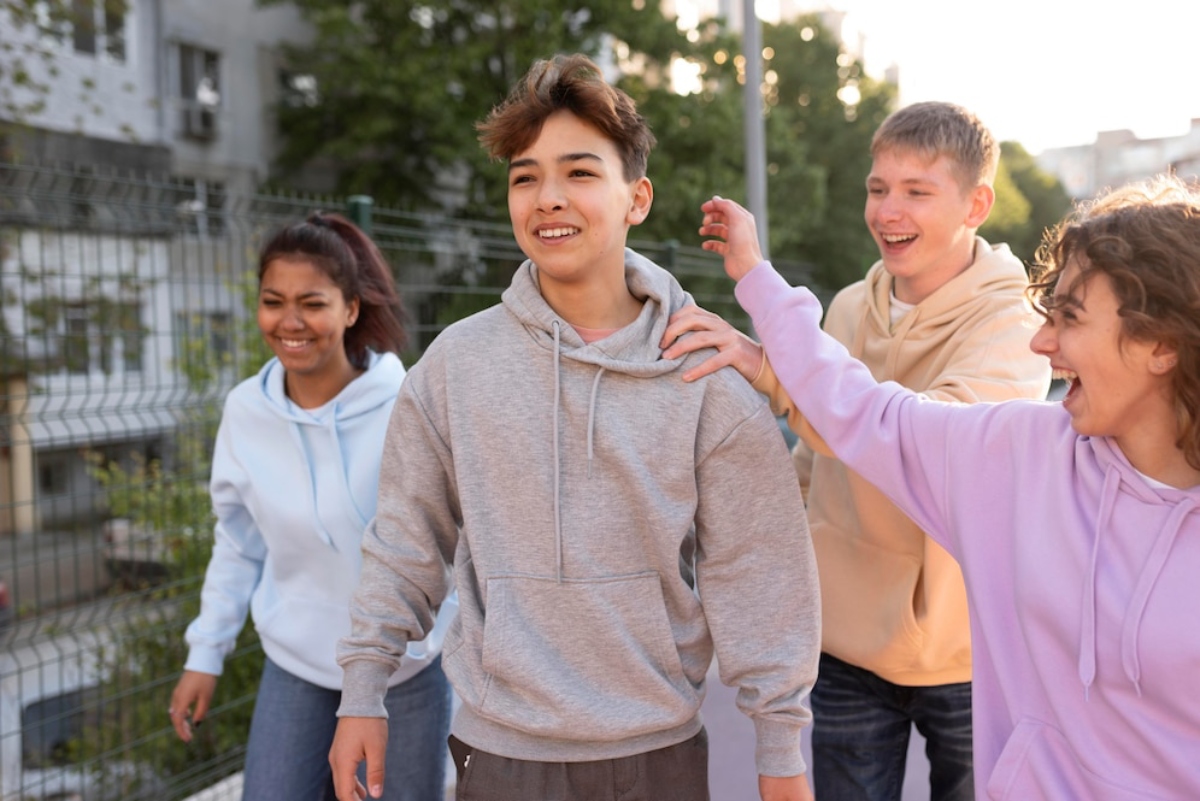
How Puberty Affects Body Image in Kids
When Bodies Change, So Does Self-Image
Puberty doesn’t just bring physical changes — it reshapes how children see themselves. One day, your child is climbing trees without a care in the world. Next, they’re standing in front of the mirror, tugging at their shirt, wondering if they “look weird.”
As a parent or caregiver, watching your child move from carefree to self-conscious can be heart-wrenching. Puberty and body image are closely connected. As hormones kick in, bodies shift, and peers start noticing differences, many kids begin to struggle with their self-image.
In this blog, we’ll explore how puberty impacts kids’ body image. We’ll discuss why these feelings arise and, most importantly, how you can help promote body positivity. This isn’t just about helping them “like” their bodies. It’s about building a strong sense of self-worth to handle the pressures of growing up.
Understanding Body Image During Puberty

What Is Body Image, Really?
Body image is how someone sees, thinks, and feels about their body. It includes:
- Perceptions (how they believe they look)
- Thoughts (“I wish I were taller”)
- Emotions (feeling proud or ashamed)
- Behaviours (checking mirrors, hiding in clothes)
For children entering puberty, these thoughts often become more intense. Their bodies change fast, often quicker than their minds can follow. This growing self-awareness can make them feel more vulnerable.
Why Puberty Triggers Body Image Concerns
Puberty brings many physical and emotional changes. These changes can challenge how a child sees themselves. These include:
- Weight gain and body fat redistribution (especially in girls)
- Breast development and periods
- Voice changes and facial hair in boys
- Acne and oily skin
- Growth spurts and height differences
- Body odour and sweat
Some changes feel exciting or grown-up. Others — particularly those that happen early or are more visible — can feel isolating or embarrassing.
Children also become more attuned to peer opinions and media images at this age. Their earlier self-confidence might fade into comparison, insecurity, or self-judgment.
Common Body Image Struggles Among Tweens
Early Bloomers vs. Late Bloomers
Puberty doesn’t follow a universal timeline. Children who mature earlier may feel “too grown-up,” attracting unwanted attention or comments. Late bloomers, on the other hand, may feel left behind.
This difference can causeSigns of poor body image may include:
- Anxiety about looking different from peers
- Feelings of shame or embarrassment
- Social withdrawal or increased self-monitoring
The Rise of the Mirror Habit
It’s normal for tweens to become more mirror-aware. But when this becomes obsessive—checking, comparing, or criticising, it can erode self-esteem.
Signs of poor body image may include:
- Refusing to wear certain clothes
- Avoiding social events or swimming
- Excessive grooming or hiding body parts
- Negative self-talk (“I’m ugly” or “I’m fat”)
These behaviours are signals, not attention-seeking, and should be met with empathy and curiosity.
Influences That Shape Self-Image During Puberty

1. Media and Social Media
Kids see edited images of “ideal” bodies everywhere, from TikTok to TV. These representations are often unrealistic or impossible to achieve. Even at a young age, kids absorb these messages.
A 2023 study by Common Sense Media found that nearly 50% of tweens using social media report that it affects their body image, often in a negative way.
2. Peers and School Environment
Friends, classmates, and even teachers can shape how a child sees themselves. Innocent teasing, locker-room comparisons, or comments like “You’re so tall!” can become internalised as flaws.
Peer dynamics also affect which changes are “celebrated” and which are scrutinised.
3. Family Messages and Modelling
Your child listens to how you speak about bodies — theirs, yours, and others’. Even offhand remarks like “I look awful today” or “I need to go on a diet” can influence their beliefs.
Families that embrace different body types and accept change help kids develop positive self-images.
How to Support a Positive Body Image During Puberty
Create a Safe Space for Body Talk
It’s essential to talk openly, positively and without shame about the changes of puberty. Instead of lecturing, invite questions. Let your child know that it’s okay to feel uncertain, awkward, or even upset about their changing body.
Try saying:
- “It’s normal to feel unsure about these changes. I went through them too.”
- “What have you noticed happening in your body lately?”
- “Is there anything that’s made you feel uncomfortable or confused?”
Use Body-Neutral Language
Encourage your child to view their body through a functional, rather than purely aesthetic, lens. Instead of focusing on looks, focus on what the body can do.
Swap:
- “You look so pretty.”
For:
- “You look strong and comfortable,” or “You seem really confident today.”
Affirm their abilities — jumping, running, growing, healing — not just their appearance.
Address Body Image Concerns Early
If your child dislikes their body, don’t dismiss it with “Don’t be silly.” Instead, explore the emotion beneath the comment.
Ask:
- “What makes you feel that way?”
- “Has something happened recently?”
- “Are there times you do feel good in your body?”
This opens the door to deeper understanding, helps them feel heard, and avoids shame-based silence.
Diversify Their Influences
Show your child different body-positive role models. You can find these in books, media, and daily life. Look for stories that highlight:
- Different body shapes, abilities, and ethnicities
- Characters who overcome appearance-based challenges
- Narratives that celebrate kindness, resilience, and creativity
Follow social media accounts that share real, unfiltered content. If it’s age-appropriate, do this together. Also, discuss what’s edited or unrealistic.
Encourage Healthy Habits Without Obsession
Rather than focusing on weight or size, centre conversations around wellbeing.
Teach your child to:
- Move their body because it feels good, not to burn calories
- Eat to fuel, enjoy, and nourish
- Rest and sleep as a form of self-respect
- Speak kindly to themselves, even on tough days
Make these habits family-wide, so it never feels like a correction or punishment.
What Not to Say When Your Child Is Struggling
Even with the best intentions, some common phrases can be unhelpful:
- “You look fine!” – May feel dismissive
- “Don’t worry, it’ll go away” – Minimises their experience
- “You should be grateful you’re tall/skinny/etc.” – Implies their feelings are invalid
Instead, try:
- “That sounds hard. Let’s talk about it.”
- “I know you’re feeling that way right now, but your body is growing and doing what it needs to do.”
- “How can I support you today?”
When to Seek Professional Help
Body image concerns can sometimes lead to bigger issues. These may include disordered eating, anxiety, or depression. If your child:
- Constantly criticises their appearance
- Avoids food or eats in secret
- Withdraws from social interaction
- Expresses hatred toward their body
…it may be time to seek support from a GP, therapist, or school counsellor.
Early intervention is key. Your child doesn’t have to “hit rock bottom” to deserve help.
Teaching Body Positivity vs. Body Neutrality
Body positivity promotes the idea that all bodies deserve love and celebration. It encourages people to feel good about their appearance, regardless of their appearance.
Body neutrality, on the other hand, allows space for indifference. It’s okay not to love your body every day. The goal is to respect and treat it well, even if you’re not always thrilled with it.
Many children find body neutrality easier to embrace during puberty’s turbulent years.
Conclusion: Self-Worth That Grows With Them

Puberty and body image are closely intertwined, but they don’t have to become a battleground. Your child can learn to accept their changing body with your patience and honesty. They can approach it with curiosity, not criticism.
The goal isn’t to shield them from every negative thought or comment. It’s to equip them with the tools to navigate those feelings and bounce back with resilience. Building a home that values kindness over perfection, function over form, and growth over comparison lays the groundwork for a healthy self-image that lasts a lifetime.
Start the conversation today: What messages is your child receiving about their body — and how can you help rewrite the script?
We’d love to hear from you. Share your thoughts, challenges, or tips in the comments. You’re not alone on this journey — and neither is your child.


